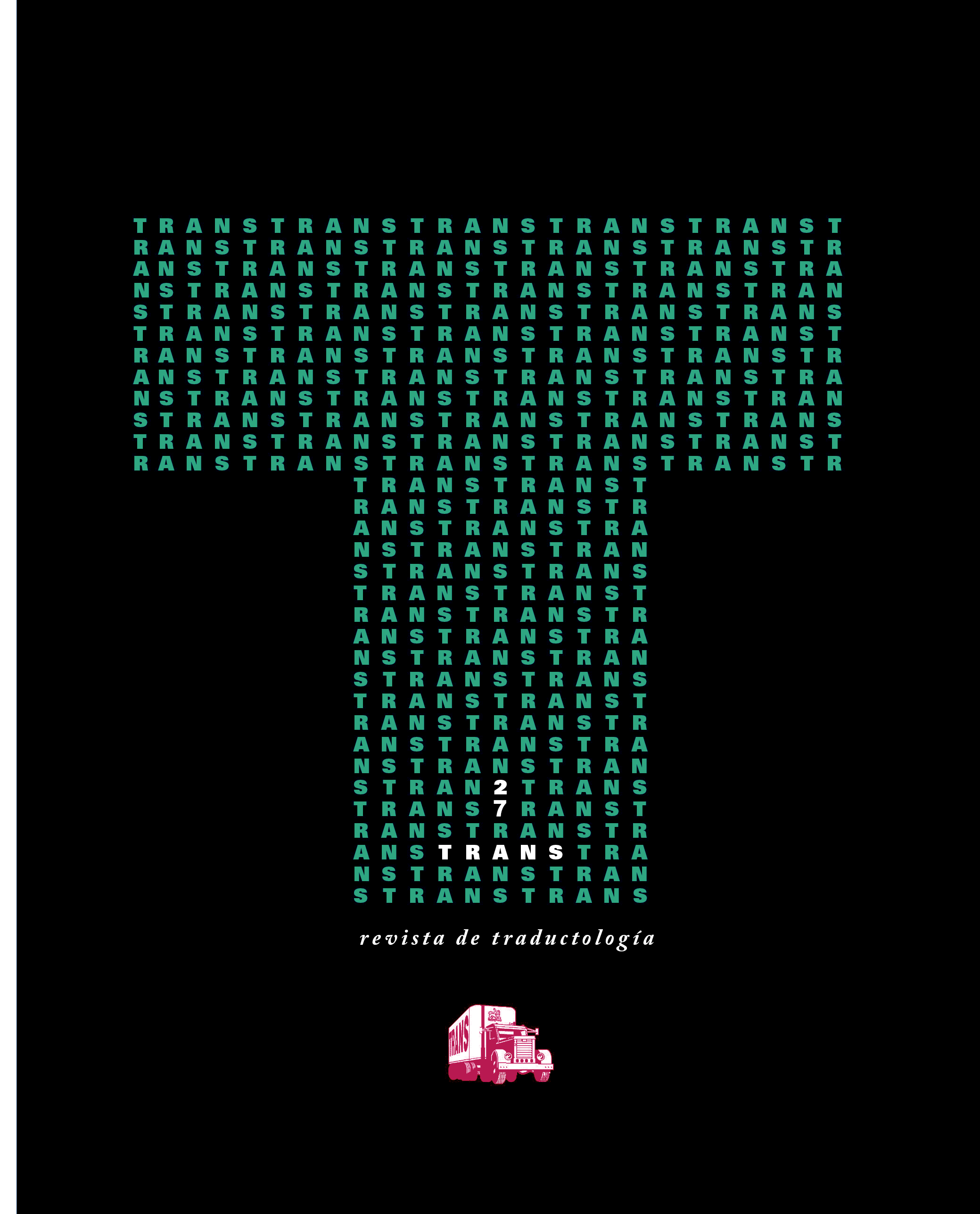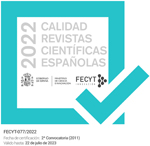Traducción de interjecciones y subtitulación: un estudio basado en el corpus BETA de subtítulos de series de televisión y películas
DOI:
https://doi.org/10.24310/trt.27.2023.15552Palabras clave:
traducción audiovisual, subtitulación, interjecciones, corpus, inglés a españolResumen
Las interjecciones, con frecuencia consideradas elementos lingüísticos periféricos y menores, no han recibido mucha atención en la investigación en el ámbito de la lingüística y de los estudios de traducción. El objetivo principal de este estudio consiste en analizar la traducción de tres interjecciones primarias y tres secundarias en un corpus inglés-español de subtítulos. Concretamente, se analizaron las interjecciones ah, wow, ugh, God, damn y shit en el corpus BETA. Se identificaron cuatro soluciones de traducción: la traducción literal, la traducción mediante una interjección con una forma diferente, la traducción mediante un fragmento textual sin ninguna interjección y la omisión. Los resultados del estudio indican que la solución de traducción más frecuente fue la omisión, seguida de la traducción por una interjección diferente. En un análisis más detallado, se demostró que las dos variables analizadas, tipo de interjección e interjección específica, condicionaron la elección de la solución de traducción.
Descargas
Métricas
Publicación Facts
Perfil de revisores N/D
Información adicional autores
Indexado: {$indexList}
-
Indexado en
- Sociedad Académica/Grupo
- N/D
- Editora:
- Universidad de Málaga
Citas
Ameka, F. (1992). Interjections: The universal yet neglected part of speech. Journal of Pragmatics 18, 101-118. https://doi.org/10.1016/0378-2166(92)90048-G
Ávila Cabrera, J. J. (2016). The subtitling of offensive and taboo language into Spanish of Inglourious Basterds. Babel 62(2), 211-232. https://doi.org/10.1075/babel.62.2.03avi
Bally, C. (1950). Linguistique générale et linguistique française. A. Francke.
Barbéris, J. M. (1992). Onomatopée, interjection : un défi pour la grammaire. L’information grammaticale 53, 52-57.
Bloomfield, L. (1933). Language. George Allen & Unwin.
Chen, C. (2004). On the Hong Kong Chinese subtitling of English swearwords. Meta, 49(1), 135-147. https://doi.org/10.7202/009029ar
Cuenca, M. J. (2000). Defining the undefinable? Interjections. Sintaxis, 3, 29-44.
Cuenca, M. J. (2002). Translating interjections for dubbing. In L. Iglesias Rábade & S. M. Doval Suárez (Eds.), Studies in contrastive linguistics. Proceedings of the 2nd International Contrastive Linguistics Conference (pp. 299-310). Universidade de Santiago de Compostela.
Cuenca, M. J. (2006). Interjections and Pragmatic Errors in Dubbing. Meta, 51(1), 20-35. https://doi.org/10.7202/012991ar
Díaz Cintas, J. (2001). Sex, (sub)titles and videotapes. In L. Lorenzo & A. M. Pereira (Eds), Traducción subordinada (II) El subtitulado (inglés-español/galego) (pp. 47-67). Universidade de Vigo.
Díaz-Pérez, F. J. (2020). Translating swear words from English into Galician in film subtitles. A corpus-based study. Babel 66(3), 393-419. https://doi.org/10.1075/babel.00162.dia
Drzazga, A. (2019). Interjections in Shakespeare’s Hamlet and their Polish translations. Linguistica Silesiana 40, 83-98. https://doi.org/10.24425/linsi.2019.129403
Farhoudi, M. (2012). Translation of interjections in drama. Babel, 58(3), 327-338. https://doi.org/io.iO75/babel.58.3.o5far
Fernández Dobao, A. M. (2006). Linguistic and cultural aspects of the translation of swearing: The Spanish version of Pulp Fiction. Babel 58(3), 222-242. https://doi.org/10.1075/babel.52.3.02fer
Gómez Capuz, J. (2001). La interferencia pragmática del inglés sobre el español en doblajes, telecomedias y lenguaje coloquial: una aportación al estudio del cambio lingüístico en curso. Tonos Digital, 2. https://www.um.es/tonosdigital/znum2/estudios/Doblaje1.htm
Gómez Guinovart, X., & Sacau Fontenla, E. (2004). Parallel corpora for the Galician language: building and processing of the CLUVI (Linguistic Corpus of the University of Vigo). En M. T. Lino et al. (Eds), Proceedings of the 4th International Conference on Language Resources and Evaluation (LREC 2004) (pp. 1179-1182).
European Language Resources Association (ELRA).
Han, C., & Wang, K. (2014). Subtitling swearwords in reality TV series from English into Chinese: A corpus-based study of The Family. The International Journal for Translation & Interpreting Research, 6(2), 1-17.
Hjort, M. (2009). Swearwords in subtitles: A balancing act. inTRAlinea, Special issue: The translation of dialects in multimedia. http://www.intralinea.org/specials/article/1718
Ivarsson, J., & Carroll, M. (1998). Subtitling. TransEdit HB.
Jing, Y. (2021). Audiovisual translation as orchestration of multimodal synergies: Expendability of interjections in intralingual film subtitling. Target, 33(1), 26-46. https://doi.org/10.1075/target.19163.jin
Jing, Y., & White, P. R. R. (2016). Why Audiovisual Translators Downplay the Interpersonal: The Case of ‘Interjections’ in English-to-Chinese Movie Subtitling. The Journal of Translation Studies, 17(4), 107-142. https:/doi.org/10.15749/jts.2016.17.4.005
Kleiber, G. (2006). Sémiotique de l’interjection. Langages, 161, 10-23. https://doi.org/10.3917/lang.161.0010
Matamala, A. (2004). Les interjeccions en un corpus audiovisual. Descripció i representació lexicográfica. [PhD thesis, Universitat Pompeu Fabra]. Biblos-e File. http://hdl.handle.net/10803/7498
Matamala, A. (2007). The translation of oh in a corpus of dubbed sitcoms. Catalan Journal of Linguistics, 6, 117-136. https://doi.org/10.5565/rev/catjl.127
Matamala, A. (2009). Interjections in original and dubbed sitcoms in Catalan: A comparison. Meta, 54(3), 485-502. https://doi.org/10.7202/038310ar
Mayoral, R. (1993). La traduccion cinematografica: el subtitulado. Sendebar, 4, 45-68.
McEnery, T. (2006). Swearing in English: Bad language, purity and power from 1586 to the present. Routledge.
Meinard, M. E. M. (2015). Distinguishing onomatopoeias from interjections. Journal of Pragmatics, 76, 150-168. https://doi.org/10.1016/j.pragma.2014.11.011
Qin, H., & Valdeón, R. A. (2019). Intercultural pragmatics and the translation of English interjections and expletives into Spanish and Chinese. Babel, 65(3), 337-354. https://doi.org/10.1075/babel.00098.qin
Quirk, R., Greenbaum, S., Leech, G., & Svartvik, J. (1985). A comprehensive grammar of the English language. Longman.
Rodríguez Medina, M. J. (2009). Consideraciones pragmáticas en la traducción de las interjecciones del inglés al español: El caso de la novela británica Jemima B. Revista de Lingüística y Lenguas Aplicadas, 4, 175-187.
Rojo, A. M., & Valenzuela, J. (2000). Sobre la traducción de las palabras tabú. Revista de Investigación Lingüística, 1(3), 207-220.
Rusu, O. C. (2015). Language functions in a comparative classification of interjections. Potential benefits to their translation. Journal of Romanian Literary Studies, 6, 920-930.
Rusu, O. C. (2016). A corpus‐based approach on the relevance of translating interjections. Professional Communication and Translation Studies, 9, 167-176.
Santamaria Ciordia, L. (2016). A contrastive and sociolinguistic approach to the translation of vulgarity from Spanish into English and Polish in the film Tie Me Up! Tie Me Down! (Pedro Almodovar, 1990). Translation and Interpreting Studies, 11(2), 287-305. https://doi.org/10.1075/tis.11.2.08cio
Shahraki, A., Karimnia, A., & Mashhaddy, H. (2012). A Skopos-based study on translation of interjections from English into Persian in drama. Elixir Linguistics and Translation, 47, 9088-9093.
Swiatkowska, M. (2006). L’interjection: entre deixis et anaphore. Langages, 161, 47-56.
Thawabteh, M. A. (2010). The translatability of interjections: A case study of Arabic-English subtitling. Meta, 55(3), 499-515. https://doi.org/10.7202/045067ar
Valdeón, R. (2020). Swearing and the vulgarization hypothesis in Spanish audiovisual translation. Journal of Pragmatics, 155, 261-272. https://doi.org/10.1016/j.pragma.2019.09.005
Valero Garcés, C. (2001). Las fórmulas rutinarias en la comunicación intercultural: la expression de emociones en inglés y en español y su traducción. In I. de la Cruz (Ed.), La lingüística aplicada a finales del siglo XX. Ensayos y propuestas, vol. 2 (pp. 635-639). Universidad de Alcalá.
Vassileva, A. (2007). Sur le traitement de la forme du signifié interjectionnel. Langages, 165, 115-122.
Wierzbicka, A. (1992). The semantics of interjection. Journal of Pragmatics, 18(2), 159-192. https://doi.org/10.1016/0378-2166(92)90050-L
Xiang, C. (2015). On Chinese Translation of English Interjections. Cross-Cultural Communication, 11(12), 15-20. https://dx.doi.org/10.3968/8027
Zamora, P., & Alessandro, A. (2016). Frequency of use and functions of Italian and Spanish interjections in film language and their impact on their Spanish dubbing. In C. Calvo Rigual & N. Spinolo (Eds.), Translating orality. Special issue 3 of Monografías de Traducción e Interpretación (pp. 1-30). https://doi.org/10.6035/MonTI.2016.ne3.7
Publicado
Cómo citar
Número
Sección
Licencia
Derechos de autor 2023 Francisco Javier Díaz Pérez

Esta obra está bajo una licencia internacional Creative Commons Atribución-NoComercial-CompartirIgual 4.0.
Todos los contenidos publicados en TRANS. Revista de Traductología están sujetos a la licencia Creative Commons Reconocimento-NoComercia-Compartirigual 4.0 cuyo texto completo puede consultar en <http://creativecommons.org/licenses/by-nc-sa/4.0>
Se pueden copiar, usar, difundir, transmitir y exponer públicamente, siempre que:
- Se cite la autoría y la fuente original de su publicación (revista, editorial y URL de la obra).
- No se usen para fines comerciales.
- Se mencione la existencia y especificaciones de esta licencia de uso.
- Compartir Igual — Si remezcla, transforma o construye sobre el material, debe distribuir sus contribuciones bajo la misma licencia que el original.
Los derechos de autor son de dos clases: morales y patrimoniales. Los derechos morales son prerrogativas perpetuas, irrenunciables, intransferibles, inalienables, inembargables e imprescriptibles. De acuerdo con la legislación de derechos de autor, TRANS. Revista de Traductología reconoce y respeta el derecho moral de los autores/as, así como la titularidad del derecho patrimonial, el cual será cedido a la Universidad de Málaga para su difusión en acceso abierto. Los derechos patrimoniales, se refieren a los beneficios que se obtienen por el uso o divulgación de las obras. TRANS. Revista de Traductología se publica en open access y queda autorizada en exclusiva para realizar u autorizar por cualquier medio el uso, distribución, divulgación, reproducción, adaptación, traducción o transformación de la obra.
Es responsabilidad de los autores/as obtener los permisos necesarios de las imágenes que están sujetas a derechos de autor.
Los autores/as cuyas contribuciones sean aceptadas para su publicación en esta revista conservarán el derecho no exclusivo de utilizar sus
contribuciones con fines académicos, de investigación y educativos, incluyendo el auto-archivo o depósito en repositorios de acceso abierto de cualquier tipo.













21.png)
